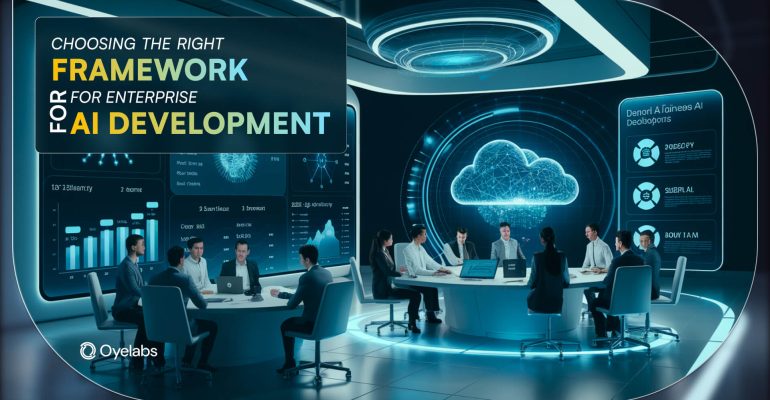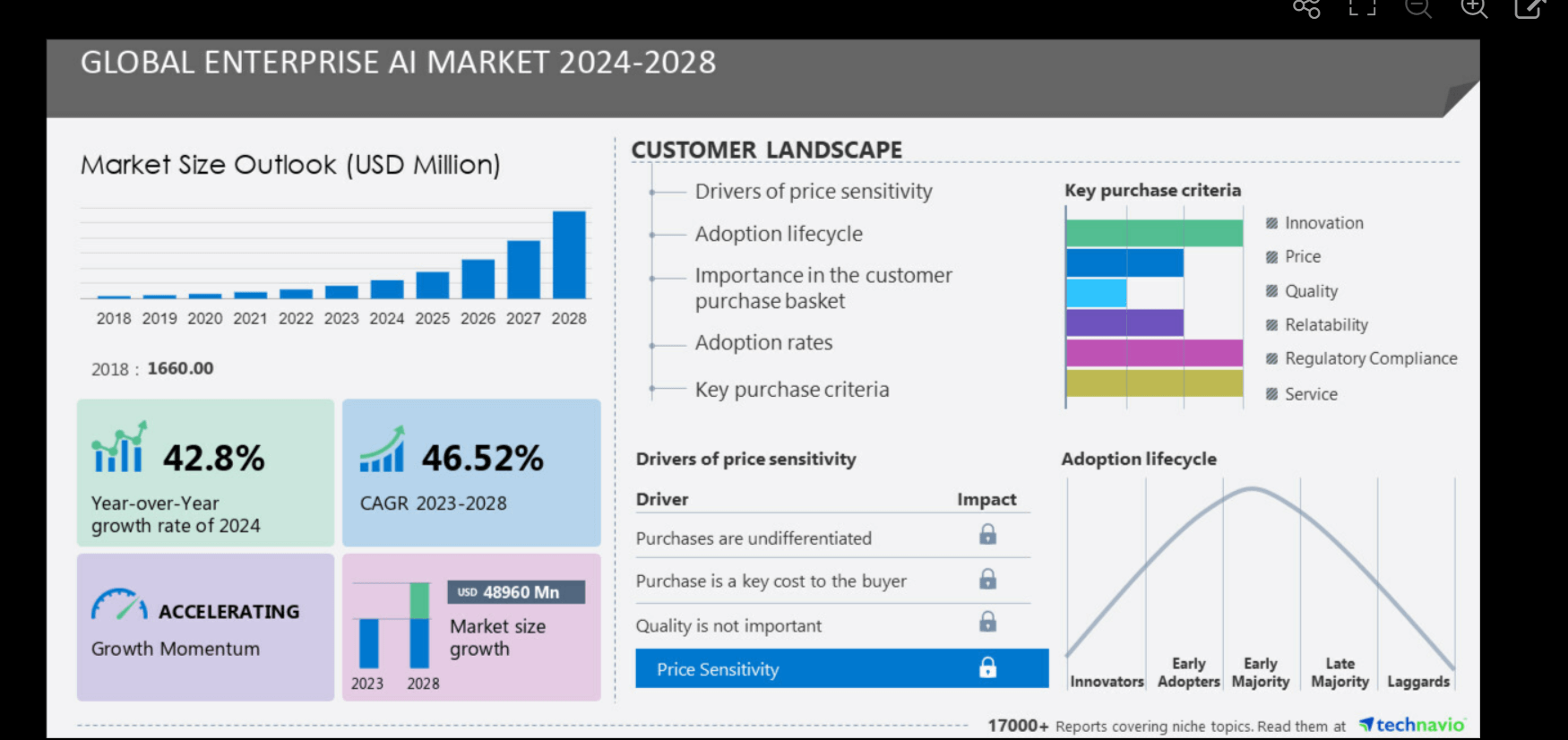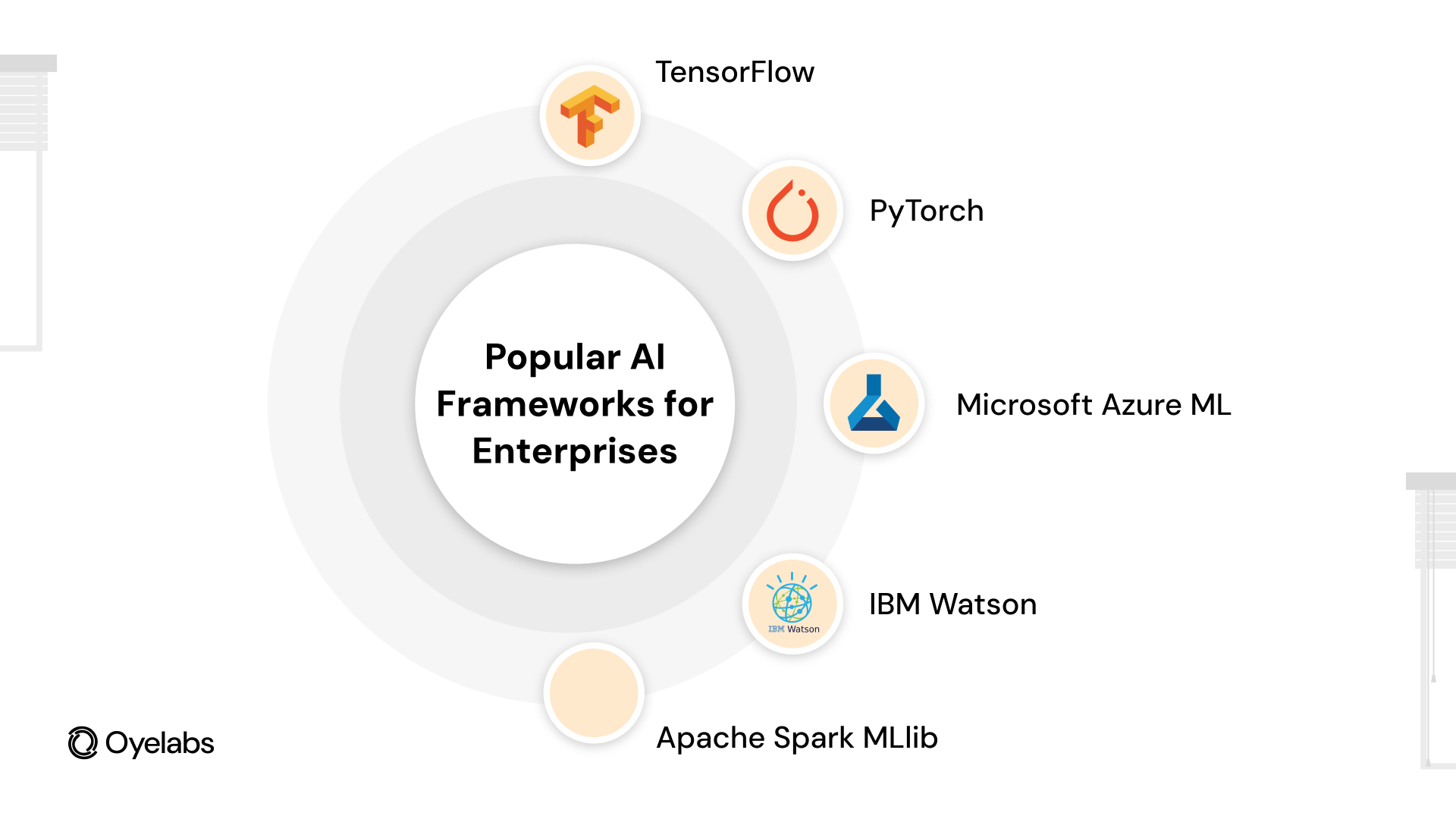Choosing the Right Framework for Enterprise AI Development

Choosing the Right Framework for Enterprise AI Development
Last Updated on March 13, 2025
Choosing the right AI framework is crucial for ensuring accuracy, scalability, and security. The wrong choice can lead to inefficiencies, increased risks, and compliance challenges. With AI adoption accelerating, 77% of businesses are either using or exploring AI, and enterprises that integrate AI into operations see a 20-30% boost in efficiency.
This article explores key considerations for selecting the best framework for enterprise AI development, comparing industry-leading solutions, and providing insights on scalability, security, and performance to help enterprises make informed decisions for long-term AI success.
Understanding Enterprise AI Needs
Before selecting an AI framework, enterprises must assess their unique requirements. The ideal AI framework should align with business objectives, integrate seamlessly into existing infrastructure, and provide scalability for future growth. With the enterprise AI market size projected to grow by USD 48.96 billion from 2024 to 2028, businesses are rapidly adopting AI-driven solutions to gain a competitive edge. Selecting the right framework ensures that AI initiatives drive efficiency, innovation, and long-term success.
 Defining Business Objectives
Defining Business Objectives
AI applications in enterprises vary widely, from automating repetitive tasks to powering advanced analytics. Identifying the business objectives behind AI adoption ensures that the chosen framework meets functional requirements.
Some common AI-driven enterprise use cases include:
- Customer Service Automation: AI-powered chatbots and virtual assistants for handling customer queries efficiently.
- Predictive Analytics: AI models that analyze historical data to forecast trends in sales, finance, and supply chain management.
- Fraud Detection and Risk Analysis: AI-driven anomaly detection for identifying fraudulent transactions in banking and finance.
- Personalized Recommendations: AI-powered recommendation engines used in e-commerce and media platforms.
- Healthcare Diagnostics: AI-assisted medical imaging, patient risk assessment, and drug discovery.
Technical Considerations
Choosing the right AI framework also depends on technical factors such as:
- Programming Language Compatibility: Some AI frameworks primarily support Python (e.g., TensorFlow, PyTorch), while others integrate well with Java, R, or C++.
- Hardware Acceleration: AI frameworks must be optimized for GPU or TPU acceleration for efficient training and inference.
- Enterprise System Integration: AI frameworks should integrate with existing cloud services (AWS, Google Cloud, Azure), databases, and APIs.
- Scalability and Performance: The ability to handle large-scale AI workloads and support distributed computing for real-time AI applications.
Compliance and Security
Enterprises in regulated industries such as finance, healthcare, and telecommunications must ensure their AI models comply with data privacy laws and security policies. The selected AI framework should support:
- Regulatory Compliance: Adherence to GDPR, HIPAA, and SOC 2 security standards.
- Data Privacy Measures: Encryption, access control, and secure data storage mechanisms.
- Audit and Logging Capabilities: To track AI model decisions and ensure transparency.
Also Read: Guide to Build an AI Copilot for Enterprises
Popular AI Frameworks for Enterprises
 AI frameworks serve as the backbone of enterprise AI development, offering the necessary tools, libraries, and infrastructure to build, train, and deploy AI models at scale. The choice of framework plays a significant role in determining the efficiency, scalability, and maintainability of AI-powered solutions. Enterprises must consider factors such as model complexity, computational requirements, integration capabilities, and industry-specific needs when selecting an AI framework.
AI frameworks serve as the backbone of enterprise AI development, offering the necessary tools, libraries, and infrastructure to build, train, and deploy AI models at scale. The choice of framework plays a significant role in determining the efficiency, scalability, and maintainability of AI-powered solutions. Enterprises must consider factors such as model complexity, computational requirements, integration capabilities, and industry-specific needs when selecting an AI framework.
In this section, we will explore the most widely used AI frameworks for enterprise applications, detailing their key features, advantages, and best-use scenarios.
TensorFlow
Developed by: Google
TensorFlow is one of the most widely adopted AI frameworks, used by 70% of AI models in production. Designed by Google Brain, it has powered advancements in deep learning across industries. Major enterprises, including Airbnb, PayPal, and Twitter, rely on TensorFlow for AI-driven personalization, fraud detection, and recommendation engines.
Key Features:
- Scalability and Performance: TensorFlow supports distributed computing, enabling enterprises to train AI models on multiple GPUs and TPUs for improved efficiency. It can handle large datasets and complex deep learning architectures with optimized performance.
- Production-Ready Deployment: TensorFlow Serving enables seamless deployment of AI models in production environments. It supports REST and gRPC APIs, allowing enterprises to integrate AI services into their existing applications.
- Extensive Ecosystem: TensorFlow Lite and TensorFlow.js enable AI deployment on mobile devices and web applications. Over 2.5 million developers worldwide have downloaded TensorFlow tools.
- AutoML Capabilities: TensorFlow includes Keras, a high-level API that simplifies model development, making AI accessible to enterprises without extensive machine learning expertise.
Best For:
- Deep Learning Applications: TensorFlow is ideal for deep learning tasks, such as image classification, object detection, and natural language processing (NLP).
- AI-Powered Predictive Analytics: Enterprises leveraging AI for business forecasting, customer insights, and risk assessment can benefit from TensorFlow’s robust analytics capabilities.
- Cloud-Based AI Deployment: TensorFlow seamlessly integrates with Google Cloud AI, making it a suitable choice for enterprises using Google’s cloud infrastructure.
PyTorch
Developed by: Meta (formerly Facebook)
PyTorch has surged in popularity among researchers and enterprises alike, with 60% of AI researchers preferring it over TensorFlow. It is known for its dynamic computation graphs, making it more flexible for experimental AI models. Companies like Tesla, Microsoft, and OpenAI rely on PyTorch for real-time AI applications.
Key Features:
- Dynamic Computation Graphs: PyTorch provides a dynamic execution model, allowing developers to modify and debug AI models in real time. This flexibility makes it an ideal choice for AI research and experimentation.
- TorchScript for Production Deployment: PyTorch supports TorchScript, which enables developers to transition models from research to production without extensive reconfiguration.
- Strong Community Support: PyTorch has a growing and active community of AI researchers and enterprise developers, ensuring continuous updates, improvements, and support.
- Seamless Integration with Cloud Services: PyTorch integrates well with Amazon SageMaker, making it a preferred choice for AI model training on AWS.
Best For:
- AI Research and Experimentation: PyTorch is widely used in academia and research institutions for developing and testing innovative AI models.
- Real-Time AI Inference: Enterprises requiring real-time AI predictions, such as fraud detection in finance or AI-powered medical diagnostics, benefit from PyTorch’s efficient inference capabilities.
- Enterprises Using AWS AI Services: Companies deploying AI models on Amazon SageMaker or AWS cloud infrastructure can take advantage of PyTorch’s seamless integration.
Microsoft Azure ML
Developed by: Microsoft
Azure Machine Learning (Azure ML) is a cloud-based AI platform designed to help enterprises build, train, and deploy machine learning models with ease. It offers both no-code and pro-code AI development tools, making it accessible to both non-technical business users and experienced data scientists.
Key Features:
- Automated Machine Learning (AutoML): Azure ML offers AutoML capabilities, allowing enterprises to automate the model selection and training process without requiring deep AI expertise.
- Seamless Integration with Microsoft Services: Azure ML works natively with Azure Data Lake, SQL Server, and Power BI, enabling businesses to incorporate AI-driven insights into their existing workflows.
- Enterprise-Grade Security and Compliance: Microsoft ensures that Azure ML adheres to industry regulations, such as GDPR, HIPAA, and SOC 2, making it a trusted choice for enterprises handling sensitive data.
- Drag-and-Drop AI Model Builder: Azure ML includes a visual interface that allows non-technical users to build AI models without writing code.
Best For:
- Enterprise Cloud AI Deployment: Businesses using Microsoft Azure as their cloud provider can benefit from Azure ML’s deep integration.
- Regulated Industries: Organizations in healthcare, finance, and government sectors that require AI solutions with built-in compliance and security.
- Enterprises Seeking Automated AI Development: Companies looking for AutoML solutions to speed up AI adoption with minimal technical complexity.
IBM Watson
Developed by: IBM
IBM Watson is an enterprise-grade AI platform designed for businesses seeking AI-powered automation, analytics, and cognitive computing solutions. Unlike general-purpose AI frameworks, Watson provides pre-trained AI models and APIs tailored to specific industries, such as healthcare, finance, and customer service.
Key Features:
- Pre-Trained AI Models: IBM Watson offers industry-specific AI models that reduce development time and costs.
- Natural Language Understanding (NLU): Watson’s AI models excel in text analytics, sentiment analysis, and speech recognition, making it a powerful tool for chatbots, virtual assistants, and AI-driven customer interactions.
- Enterprise-Grade Security: IBM Watson is built with compliance in mind, supporting regulations such as HIPAA (for healthcare AI applications) and GDPR (for data privacy).
- AI-Powered Business Analytics: Watson’s AI capabilities extend to business intelligence, offering AI-driven insights for decision-making.
Best For:
- AI Applications in Regulated Industries: Financial institutions, healthcare providers, and government agencies benefit from Watson’s security and compliance features.
- Enterprises Seeking AI-Powered Automation: Businesses looking to enhance customer interactions through AI chatbots and voice assistants.
- Companies Using IBM Cloud Infrastructure: Organizations already leveraging IBM’s enterprise cloud solutions will find Watson’s AI tools highly compatible.
Apache Spark MLlib
Developed by: Apache Software Foundation
Apache Spark MLlib is designed for big data AI applications, with 50% of AI-powered recommendation engines running on Spark (Apache AI Trends, 2024). It is widely used in enterprises handling large-scale data processing.
Key Features:
- Distributed Computing: Spark MLlib leverages Apache Spark’s parallel processing capabilities, making it ideal for large-scale AI workloads.
- Seamless Integration with Big Data Ecosystems: Spark MLlib integrates with Hadoop, Apache Kafka, and cloud-based data warehouses, enabling AI-driven big data analytics.
- Supports Multiple ML Algorithms: Spark MLlib provides built-in support for common machine learning algorithms, including logistic regression, decision trees, and collaborative filtering.
Best For:
- Enterprises Handling Large-Scale AI Workloads: Businesses dealing with massive datasets in industries like finance, e-commerce, and telecommunications.
- AI Applications Requiring Batch and Real-Time Processing: Companies that need AI-driven insights in real time, such as real-time fraud detection and predictive maintenance.
Also Read: Use Cases of AI in Enterprise
Considerations for Choosing the Right AI Framework
Ease of Development and Deployment
Selecting an AI framework that simplifies development and deployment is crucial for enterprises aiming for fast AI adoption. Frameworks with intuitive APIs, pre-trained models, and automation tools significantly reduce the complexity of building AI models. For instance, Azure ML provides drag-and-drop functionality, while TensorFlow’s Keras API offers a high-level approach for model building. According to Gartner, by 2025, 70% of enterprises will adopt AI solutions with minimal coding requirements to accelerate deployment. Additionally, frameworks that support cloud integration, containerization (Docker, Kubernetes), and multi-platform deployment streamline the transition from model development to real-world implementation.
Cost Efficiency
AI framework selection impacts both short-term and long-term costs, including licensing fees, computational resources, and maintenance. Open-source solutions like PyTorch and TensorFlow eliminate licensing costs but may require in-house expertise for customization. In contrast, IBM Watson and Google Cloud AI provide managed AI services with pricing based on usage.
A McKinsey report indicates that firms adopting AI strategically can reduce operational costs by 20-30% due to automation and predictive analytics. Businesses must assess whether investing in a managed AI service offsets infrastructure and labor costs, ensuring a balance between affordability and scalability.
Community Support and Ecosystem
An active developer community and extensive ecosystem can significantly enhance an AI framework’s reliability and evolution. TensorFlow and PyTorch benefit from large global communities, ensuring frequent updates, bug fixes, and access to pre-built models. According to Stack Overflow’s 2023 Developer Survey, over 60% of AI developers prefer frameworks with extensive documentation and community-driven support. Additionally, enterprise-grade AI frameworks like Azure ML and IBM Watson provide dedicated support, security patches, and integration with cloud services. A strong ecosystem ensures that enterprises can access the latest AI advancements and solutions without facing stagnation due to limited framework improvements.
Vendor Lock-In Risks
Vendor lock-in occurs when enterprises become dependent on a specific provider’s AI framework, limiting flexibility and future scalability. Proprietary AI platforms like IBM Watson and Google Cloud AI offer powerful tools but can lead to high migration costs if switching providers. In contrast, open-source alternatives like TensorFlow, PyTorch, and Apache Spark MLlib provide greater flexibility, enabling companies to transition between cloud and on-premise environments seamlessly. A 2024 IDC report states that 65% of enterprises are prioritizing open-source AI frameworks to reduce dependency on single vendors and maintain long-term control over their AI infrastructure and data sovereignty.
Performance Benchmarks
Benchmarking AI frameworks ensures they meet enterprise requirements in terms of speed, efficiency, and scalability. Organizations should analyze training speed, inference latency, and model accuracy under real-world conditions. TensorFlow and PyTorch are optimized for GPU/TPU acceleration, significantly reducing training time for deep learning models. According to Stanford’s DAWNBench results, TensorFlow can train ResNet-50 on ImageNet in under 30 minutes using TPUs, making it one of the fastest frameworks for image processing tasks. Enterprises deploying AI for real-time analytics, such as fraud detection, should prioritize frameworks that offer low-latency inference and efficient resource utilization.
Building an AI-Powered Future with Oyelabs
Selecting the best AI framework is a critical step in enterprise AI development. By considering factors like project requirements, scalability, cost, and security, businesses can make informed choices that drive innovation and efficiency.
At Oyelabs, we specialize in developing AI-powered enterprise solutions tailored to your business needs. Whether you need a robust recommendation engine, advanced NLP capabilities, or intelligent automation, our team is equipped to deliver AI solutions that enhance efficiency and drive growth.
Let’s transform your business with the right AI framework. Contact Oyelabs today and take the next step in your AI journey.
Conclusion
Selecting the right AI framework for enterprise AI development is a strategic decision that influences scalability, performance, security, and business value. TensorFlow and PyTorch excel in deep learning capabilities, while Microsoft Azure ML and IBM Watson provide enterprise-grade AI solutions with built-in compliance. Amazon SageMaker stands out for cloud-based AI applications. Enterprises must align their framework choice with business goals, integration needs, and security requirements to ensure successful AI adoption. By evaluating the strengths and trade-offs of each framework, businesses can deploy AI solutions that drive innovation, efficiency, and competitive advantage.




